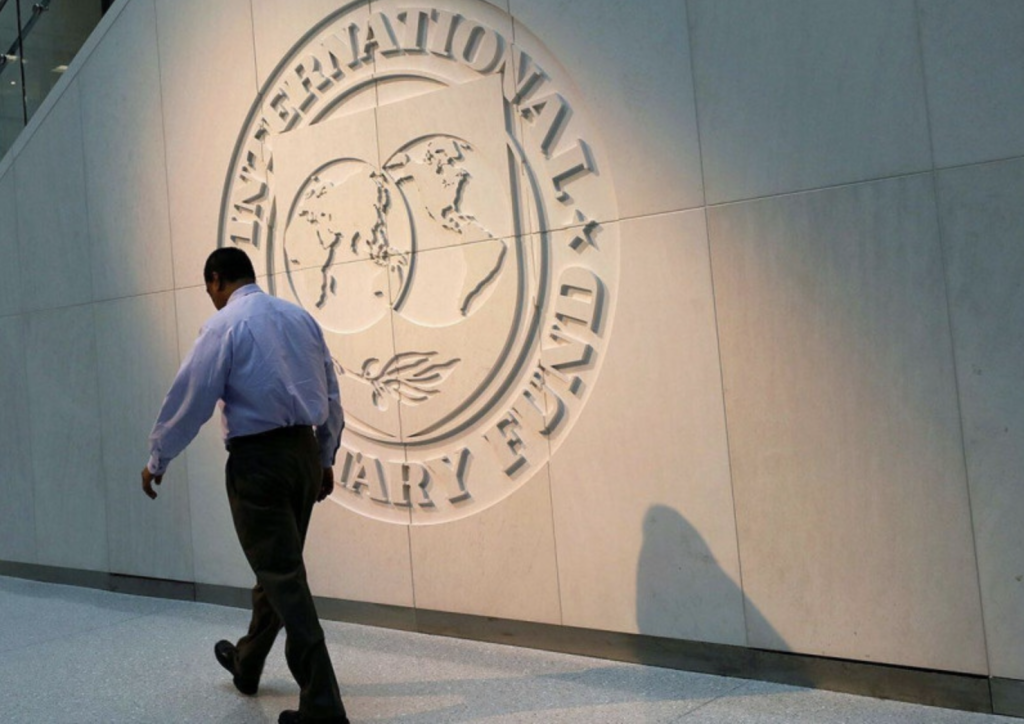By Dolores Vicioso
Copyright dr1

The International Monetary Fund has issued its concluding statements after the routine annual review of the evolution of the Dominican economy. Overall, the IMF states that despite the uncertain external environment, “the DR is well positioned to weather the impact” and states that structural reforms to enhance competitiveness could bolster long-term growth.
The IMF states:• The Dominican Republic’s (DR) remarkable economic performance over the past two decades has been driven by strengthening policies and institutions, social and political stability, and business-friendly reforms. This has enabled the fastest rate of income convergence in Latin America and the Caribbean over this period.• Heightened global uncertainty and tighter external and domestic financing conditions have weighed on activity this year, but the authorities’ recent policies and the economy’s strong fundamentals underpin a positive outlook.• Strengthening the monetary transmission mechanism will support the Central Bank’s (BCRD) ongoing normalization of monetary policy. The mission welcomes the recent increased flexibility of the Peso, and the exchange rate remains in line with the fundamentals of the economy and prudent policies.• Continued fiscal prudence should be accompanied by measures to create space to scale up investment and maintain debt on a downward path. Reforms and investments to bolster the electricity sector are key to easing fiscal pressures and supporting growth.• Complementary structural reforms to bolster human capital, competitiveness, and resilience to natural disasters will be crucial to boost potential growth in line with the country’s Meta2036 objectives.
Recent economic developments, outlook, and risksA strong growth rebound in 2024 was driven by external demand and ample liquidity conditions. Real GDP expanded by 5 percent on the back of robust exports and strong credit growth in the first half of 2024. The credibility of the inflation-targeting regime has helped maintain inflation within the BCRD’s target since late 2023—averaging 3.6 percent y/y in 2025—with inflation expectations well anchored. The current account deficit narrowed to 3.3 percent of GDP in 2024, fully financed by FDI, and the external position remained broadly in line with fundamentals and desirable policies. The 2024 budgetary central government deficit narrowed to 3.1 percent of GDP with one-off revenues offsetting an increase in energy subsidies. The banking sector remains resilient, well-capitalized and highly profitable.
High uncertainty and tighter financing conditions weighed on the economy in the first half of 2025, but policy measures and strong fundamentals underpin a favorable outlook. Real GDP growth is projected at around 3 percent in 2025. The BCRD’s liquidity measures enacted in June and the reformulated budget’s fiscal stimulus should support a pick-up in activity in the second half of the year and help to close the output gap. Beyond 2025, growth is expected to gradually return to its potential, supported by investment and productivity growth in line with past trends. Inflation is expected to remain around the 4 percent target. The current account deficit is projected to remain at around 2½ percent of GDP and financed by FDI. The central government deficit in 2025 is expected to increase to around 3.5 percent of GDP due to the boost in capital spending from the reformulated budget. Thereafter, gradual fiscal consolidation will continue to be guided by the fiscal rule.
The balance of risks is tilted to the downside stemming from a highly uncertain external environment, but the DR is well positioned to weather the impact. External risks remain elevated from continued high uncertainty and possibly tighter global financial conditions, which could further weigh on sentiment and economic activity. The DR also remains vulnerable to natural disasters. Moreover, reform delays, including those aimed at reducing the electricity sector deficit, could weaken the fiscal and external sectors. On the upside, the DR could benefit from trade diversion and greater FDI flows stemming from changes in global trade policies. Reforms that boost revenues would enable greater capital and social spending, as well as further reduce sovereign risk premia. Finally, structural reforms to enhance competitiveness could bolster long-term growth.
Near-term policies should remain focused on closing the output gap, safeguarding macro-financial stability, and navigating elevated uncertainty. Further enhancing the coordination of monetary and fiscal policies is critical to boost their effectiveness and impact.• Fiscal policy: The government should boost public investment under the reformulated budget, maintaining primary spending within the limits of the Fiscal Responsibility Law (FRL). Going forward, gradually lowering electricity subsidies while supporting the most vulnerable remains paramount to safeguard needed capital and social spending. Greater detail in the Medium-Term Expenditure Framework on the measures to better target subsidies would bolster the fiscal consolidation strategy.• Monetary policy: The BCRD and the inflation-targeting regime remain pillars of economic stability. The current monetary policy stance is broadly appropriate and future policy decisions should remain guided by the expected evolution of inflation and the economic outlook. In this context, a comprehensive and clearly-communicated strategy to gradually wind down the existing exceptional liquidity measures in conjunction with the rollover of maturing BCRD securities should ensure that adequate system liquidity is preserved. This would strengthen the transmission mechanism.• Exchange rate policies. The BCRD has appropriately allowed greater exchange rate flexibility consistent with the inflation-targeting regime. Going forward, the exchange rate should continue to act as shock absorber and remain in line with economic fundamentals, with interventions focused on smoothing large shocks. Further FX reserve accumulation will strengthen external stability.• Financial sector policies: The mission commends the monetary and financial authorities for the recent enhancements to consumer protection requirements, the planned approval of updated operational risks framework, and the implementation of mark-to-market effective January 2026. Moving forward, adoption of Basel II and III standards for capital requirements and capital and liquidity buffers should remain a priority. Enhanced macroprudential and resolution tools would further support financial stability. Adoption of the amended Savings and Loans Cooperatives Law will strengthen oversight and enhance compliance with AML/CFT standards.• Electricity sector policies: Resuming the full implementation of the Electricity Pact will be essential to limit fiscal risks and ensure the sector becomes an engine of growth. Gradual adjustments to technical tariffs and better targeting of subsidies, along with much-needed investments in the grid, are key to strengthening the sector’s financial sustainability.
Over the medium term, the authorities should build on their steadfast efforts to further advance policy frameworks and reforms to boost private investment, inclusive growth, and job creation. The close dialogue among relevant stakeholders (public, private, and civil society) bodes well for these initiatives.• Further efforts to strengthen spending and revenue efficiency are needed to create fiscal space for essential investments in physical and human capital. Besides reducing untargeted subsidies, further strengthening public investment management, prudent use of PPPs for strategic infrastructure projects, and robust implementation of the new procurement law would improve spending efficiency. Continued efforts to improve tax compliance would generate revenue gains while enhanced administration of fiscal incentives should ensure these deliver on their employment and competitiveness objectives. Developing a medium-term revenue strategy, in consultation with the private and social sectors, could help build consensus for a tax reform that can deliver on the investment and development objectives.• There is scope to further enhance the effectiveness of the inflation-targeting framework. Continuing to develop the interbank market would allow banks to manage liquidity more flexibly. Expanding the use of FX hedging mechanisms, including ensuring an enabling regulatory environment, would support external stability and reserve accumulation. The BCRD has continued to improve its communication and transparency by publishing informative scenarios in the monetary policy report. The mission welcomes the authorities’ plans to increase the frequency of monetary policy reports and expand data provision.• The authorities should develop a comprehensive strategy to recapitalize the BCRD. The BCRD and the Ministry of Finance and Economy should continue to work together to design and implement a comprehensive plan to recapitalize the BCRD, taking into account the potential impact on the monetary and fiscal positions.• Ambitious structural reforms are critical to deliver resilient growth and reach high-income status as envisioned in the Meta2036 plan. Given the DR’s exposure to natural disasters, an enhanced climate policy legal framework, improved disaster risk management, and deeper integration of climate considerations into fiscal policy can help build resilience. Deepening financial markets and inclusion, bolstering labor market flexibility while enhancing human capital, and improving business regulation should generate higher growth.• Key milestones have been achieved to strengthen data quality and timeliness. The commendable efforts that have led to the publication of rebased national accounts should now be followed by timely adoption of the IMF’s Special Data Dissemination Standard (SDDS).
The mission met with Central Bank Governor Héctor Valdez Albizu, Minister of Finance Magín Diaz, other senior officials, and representatives of the civil society and the private sector. The team would like to express its sincere gratitude to the authorities for their exceptional hospitality, full cooperation, and open, frank and productive dialogue.
Read more:IMF
16 September 2025



